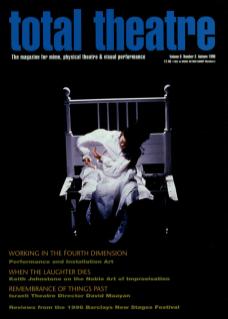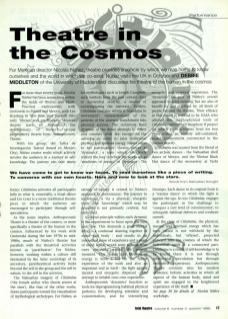For more than twenty years, Nicolás Núñez has been researching within the fields of theatre and ritual.
Practical explorations with Grotowski in Poland and Mexico, with Lee Strasberg in New York, and research into early Tibetan and pro-Hispanic Mexican theatre have all influenced the development of Núñez's unique participatory theatre form, Anthropocosmic Theatre.
With his group, the Taller de Investigación Teatral (based in Mexico City), Núñez creates works which actively involve the audience in a journey to self-knowledge. The journey can take many forms: Citlalmina activates all participants fully in what is, essentially, a ritual dance and Los Cenci is a more traditional theatre piece in which the audience are encouraged to participate through self-speculation.
As the name implies, Anthropocosmic Theatre is a theatre of the cosmos, or more specifically a theatre of the human in the cosmos. Influenced by his work with Grotowski during the late 1970s to mid-1980s, much of Núñez's theatre has parallels with the theatrical activities known as 'paratheatre'. For Núñez, however, working within a culture still fascinated by the Aztec cosmology of its ancestors, paratheatrical activity looks beyond the self in the group and the self in nature, to the self in the universe.
The Nahuatlan imagery of Citlalmina ('the female archer who shoots arrows at the stars'), like that of the other works, draws participants toward the visualisation of mythological archetypes. For Núñez, as for mythologists such as Joseph Campbell, such symbols from the past contain clues to existential security, a means of contemplating the universe. Further, Citlalmina contains within it 'mandalas in movement'; representations of the patterns of the universe transformed into physical actions. The continual fluid dynamic of the dance attempts to reflect and connect with the energy of the universe in order to raise individual physical and spiritual energy. Núñez refers to his participatory theatre pieces as ‘dynamics', a term which effectively reflects the way in which the works act as ‘machines of energy or dynamos’. The raising of energy is central to Núñez's approach to performance. The journey to knowledge is via a physical, energetic route. The 'knowledge’ which may be acquired is not primarily cerebral, but embodied.
We have come to get to know our faces. To read ourselves like a piece of writing. To converse with our own hearts. Here and now to look at the stars. – Words from Nahuatlan thought
A central principle within each dynamic is the requirement to focus upon the here and now. This demands a great mental effort – a continual drawing together of mind and body – and results in an intensified sense of experience and a peace of mind which would seem to arise from one’s centrality within the present moment. This raising and focusing of energy is both a key to the fullest experience of the work and also an important end in itself – the fight against mental and energetic dispersal – the attempt to inhabit one’s own experience.
Anthropocosmic 'dynamics' function as tools for deprogramming habitual physical patterns; for developing attention and concentration; and for intensifying energetic and corporeal experience. The 'dynamics' are part of Núñez's overall approach to actor-training, but are also of benefit to, and practised by, all kinds of people beyond the theatre. Their efficacy in this regard is testified to by NASA who utilised the psychophysical tools of Citlalmina within their Biosphere II project (in which eight scientists lived for two years within an entirely self-contained, sealed environment constructed in the Tucson desert).
Citlalmina was created from the blend of two archaic dances – the Nahuatlan shell dance of Mexico, and the Tibetan Black Hat dance of the monastery at Tashi Lhumpo. Each dance in its original form is a 'warrior dance' in which the fight is against the ego. So too Citlalmina engages the participant in the challenge to 'conquer a new level of consciousness', to relinquish habitual defences and confront oneself.
At the close of Citlalmina, the physical, mental and spiritual energy which has been raised is not withheld by the individuals, but ‘offered' – projected outward into the cosmos of which the individual spirit is a connected part. Citlalmina is a ritual; if self-knowledge is to be found there it is not through intellectual speculation but through embodied experience. Anthropocosmic Theatre contains rites for modern existence; holistic activities in which all aspects of the human body, mind and spirit are engaged in the heightened experience of life itself.

